在vue2中会习惯性的把axios挂载到全局,以方便在各个组件或页面中使用this.$http请求接口。但是在vue3中取消了Vue.prototype,在全局挂载方法和属性时,需要使用官方提供的globalPropertiesAPI。
一、全局挂载
- 在
vue2项目中,入口文件main.js配置Vue.prototype挂载全局方法对象:
1 | |
- 在
vue3项目中,入口文件main.js配置globalProperties挂载全局方法对象:
1 | |
二、全局使用
- 在
vue2中使用this.$http:
1 | |
- 在
vue3的setup中使用getCurrentInstanceAPI获取全局对象:
1 | |
- 方法一:通过
getCurrentInstance方法获取当前实例,再根据当前实例找到全局实例对象appContext,进而拿到全局实例的config.globalProperties。 - 方法二:通过
getCurrentInstance方法获取上下文,这里的proxy就相当于this。
提示: 可以通过打印getCurrentInstance()看到其中有很多全局对象,如:$route、$router、$store。如果全局使用了ElementUI后,还可以拿到$message、$dialog等等。
《Vue3学习与实战》系列
- Vue3学习与实战 · 组件通信
- Vue3学习与实战 · 全局挂载使用Axios(本文)
- Vue3学习与实战 · 配置使用vue-router路由
- Vue3学习与实战 · Vuex状态管理
- vue3 + vite实现异步组件和路由懒加载
- Vite+Vue3+Vant快速构建项目
欢迎访问:天问博客
本文作者: Tiven
发布时间: 2021-11-24
最后更新: 2024-01-04
本文标题: Vue3学习与实战 · 全局挂载使用Axios
本文链接: https://www.tiven.cn/p/7f7ba3b2/
版权声明: 本作品采用 CC BY-NC-SA 4.0 许可协议进行许可。转载请注明出处!
发布时间: 2021-11-24
最后更新: 2024-01-04
本文标题: Vue3学习与实战 · 全局挂载使用Axios
本文链接: https://www.tiven.cn/p/7f7ba3b2/
版权声明: 本作品采用 CC BY-NC-SA 4.0 许可协议进行许可。转载请注明出处!


